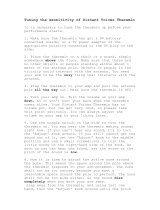
doepfer
System A - 100
LOGIC
A-166
1
1. Introduction
Module A-166 is a dual logic device to combine digi-
tal control signals.
It contains
2 identical units
with
3 inputs
for each
unit. The logical states of the inputs ("1" = high / "0" =
low) are
linked
together in 3 ways:
AND, OR, EXOR
(exclusive OR).
The three functions are available simultaneously at
three outputs with LED display of the output states.
Additionally two inverters are avaliable to obtain the
inverted functions NAND, NOR
and
NEXOR
.
The
input sockets
of each triple unit are
"normalized", i.e. the switched contact of socket 2 is
connected to input 1 and the switched contact of
socket 3 is connected to input 2.
A typical application is the combination of digital
signals of the A-100 (gates, clocks, triggers), e.g. to
obtain
"gated" clocks
or
rhythmic clock patterns
.
A-166
Logic
Input 1
Input 2
Input 3
AND Output
OR Output
XOR Output
Input
INV Output

A-166
LOGIC
System A - 100
doepfer
2
2. LOGIC - Overview
Controls:
1
LED : Display of the logical state for the
corresponding output
In / Outputs:
!
(
Input) 1, 2, 3
: Inputs for the AND, OR,
and XOR function
" (Output) AND,OR,XOR: Output of the correspon-
ding function
§ (Input): Inverter input
$ (Output) INV
: Inverter output
A-166
Logic
Dual Logic Module
➀
1
2
3
4
5
6
7
8
F
AND
OR
XOR
F
AND
OR
XOR
INV
INV
-1
-1

doepfer
System A - 100
LOGIC
A-166
3
3. Controls
1 LEDs
The LEDs display the logical state of the correspon-
ding output (on = logical “1” / high, off = logical “0” /
low).
4. In / Outputs
! Input 1 • Input 2 • Input 3
The sockets Input 1, 2 and 3 are the common inputs
of the logical functions AND, OR and XOR. The digital
control signals that have to be linked (e.g. gate, clock)
are connected to these sockets.
If “normal” analog voltages are used as inputs any
voltage less than about +1 V corresponds to a logical
“0” (low); voltages above about +2 V are taken as
logical “1” (high).
The sockets of each triple unit are "normalized", i.e.
the switched contact of socket 2 is connected to input
1 and the switched contact of socket 3 is connected to
input 2. Provided that no plug is inserted into socket 1
resp. socket 2 the socket is connected to the input
above it.
Table 1: Logical functions of the A-166
This simplifies the usage of the module if only 2
signals have to be combined. Otherwise the third
input would have to be fed with the neutral level for
the desired logical function. As the logical functions
have different neutral levels this would cause pro-
blems. E.g. the logic functions AND and OR have
different neutral input levels: "1" is the neutral state for
AND, "0" is the neutral state for OR. In case of a fixed
input level for the unused input one of the two functi-
ons (AND or OR) would work no longer.
1 2 3 AND OR XOR NAND NOR NEXOR
000 0 0 0 1 1 1
001 0 1 1 1 0 0
010 0 1 1 1 0 0
011 0 1 1 1 0 0
100 0 1 1 1 0 0
101 0 1 1 1 0 0
110 0 1 1 1 0 0
111 1 1 0 0 0 1
Inputs Outputs

A-166
LOGIC
System A - 100
doepfer
4
" AND • OR • XOR
These are the output sockets for the three logical
functions. The output of each state depends upon the
on the three inputs (refer to table 1). A logical “0”
corresponds to about 0V (in every case less than
+1V), “1” to +12V (at least +10V).
§
Input
Socket
§
is the input of the inverter.
$ INV Output
At the
inverter output $
the inverted signal of the
inverter input
§
is available. A logical “0” at the input is
converted to “1” and vice versa.
By means of the inverters it is possible to invert a
signal before it is fed into one of the two logical units.
In addition the inverse logical functions NAND
(negated AND), NOR (negated OR) and NEXOR
(negated exclusive OR) can be realized (see table 1,
right columns).
The voltage ranges that correspond to “0/low” and
”1/high” state for the inputs and outputs of the inverters
are the same as for the logical functions.
5. User Examples
The A-166 can be used to combine all kind of digital
signals of the A-100 (i.e. clock, gate or trigger signals).
Therefore manifold applications like gated clocks or
the creation of complex rhythmical structures are pos-
sible. A typical example is the combination of signals
coming from a clock source (e.g. clock ouput of A-190,
rectangle output of a LFO), clock divider (A-160), clock
sequencer (A-161) or analog/trigger sequencer (A-
155) with each other or with other digital signals like
gate or trigger e.g. from the MIDI interface A-190,
Theremin A-178, Trautonium/Ribbon Controller A-198,
Trigger delay A-162, VC decay/gate A-142, VC divider
A-163 or external input A-119.
A typical example shows the patch in fig. 1. The
outputs “1”, “5” and “7” of the clock sequencer A-161
are “added” with the A-166 (OR function) and this
signal is “gated” with the clock output “8” of the clock
divider A-160 (AND function).
Likewise it is possible to derive a gate signal from an
audio signal using the external input/envelope follower
A-119 and combine this with other clock, gate or
trigger signals.

doepfer
System A - 100
LOGIC
A-166
5
Fig. 1: Patch for generation of rhythmic
clock signals
A-161
1
2
3
4
5
6
7
8
Out
A-160
/ 2
/ 4
/ 8
/ 16
/ 32
/ 64
Trig.
In
A-166
Clock In
OR
Out
Clock
A-161 "1"
A-161 "5"
A-161 "7"
A-166 "OR Out"
A-160 "/ 8"
Out

A-166
LOGIC
System A - 100
doepfer
6
6. Patch-Sheet
The following diagrams of the module can help
you recall your own Patches. They’re designed so
that a complete 19” rack of modules will fit onto an
A4 sheet of paper.
Photocopy this page, and cut out the pictures of
this and your other modules. You can then stick
them onto another piece of paper, and create a
diagram of your own system.
Make multiple copies of your composite diagram,
and use them for remembering good patches and
set-ups.
P Draw in patchleads with colored pens.
A-166
Logic
Dual Logic Module
1
2
3
4
5
6
7
8
F
AND
OR
XOR
F
AND
OR
XOR
INV
INV
-1
-1
A-166
Logic
Dual Logic Module
1
2
3
4
5
6
7
8
F
AND
OR
XOR
F
AND
OR
XOR
INV
INV
-1
-1
/

